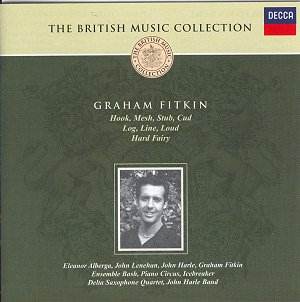This is a useful anthology of music by the young Cornish
composer Graham Fitkin, reissuing pieces which first appeared
on the Argo label in the 1990s. The selection ranges from small
ensemble items on the first disc to a mixture of pieces for band
or piano on the second.
Early influences included Steve Reich and Fitkin's
teacher Louis Andriessen. This is especially apparent in the more
minimalist pieces for piano sextet (Log, Line and
Loud) and the other works for more mixed ensemble on disc
one. Rhythm, especially of the jazz-based percussive type is also
a major feature, although even here signs of a more lyrical, expansive
style are becoming apparent.
I enjoyed the second disc much more, with the
twin presences of the composer (as pianist and conductor) and
John Harle (as leader of his own band and as featured saxophonist)
looming large. The first piece Cud, written for the Cleveland
Youth Jazz Orchestra, is given a superlative performance. The
booklet notes make much of the idea that, despite borrowing from
jazz, Fitkin is, in essence, a classicist with little truck with
improvisation. He finds this piece "hysterically funny". It is
certainly entertaining but it is much more than the send-up hinted
at. The rest of the second disc features a much more pared-down
set of pieces. This is crowned by the superb Hard Fairy,
in which the composer is joined by John Lenehan and Harle to create
a piece which truly soars. It reminds me very much of Michael
Nyman's lovely Where the Bee Dances. What remains is either
played at the piano alone by Fitkin and very impressive it is
too. In the case of Aract and the extended Fract,
the composer plays in duet with fellow pianist Eleanor Alberga.
Despite the mostly functional titles, much of this music is introspective,
subdued but very beautifully put together. It reminded me occasionally
of the solo piano tracks with which fellow Cornishman and electronic
wunderkind Richard D. James (aka Aphex Twin) intersperses
his more abstract works. James has also collaborated with Philip
Glass and Gavin Bryars, which makes sense of the comparison, I
suppose. Some of the pieces, e.g. Blue, are dance or other
media-related reconstructions. However there is still a sense
of fragility and even nostagia which is more or less all-pervading.
In conclusion, the first disc may contain the
more radical works but I will return much more often to the exuberantly
and winningly lyrical Hard Fairy and the delicate minor
key studies of its companions on disc two. All in all this is
an excellent choice for reissue in Decca's British Music Collection,
and worthy of your attention.
Neil Horner
